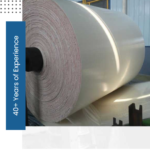Conveyor belts play a crucial role in various industries, efficiently transporting materials across distances. But what happens when those materials are scorching hot? Enter the realm of heat resistant conveyor belts, specially designed to handle high temperatures without melting, losing strength, or compromising safety.
What is a Heat Resistant Conveyor Belt?
A heat-resistant conveyor belt is a specialized type of conveyor belt designed to withstand high temperatures and extreme heat environments. Typically constructed from materials like rubber, silicone, or synthetic fibers, these belts are engineered to maintain their structural integrity and functionality even when exposed to temperatures ranging from 150°C to over 300°C.
Heat resistant c are commonly used in industries such as steel manufacturing, foundries, glass production, and certain types of chemical processing where conveying materials at elevated temperatures is essential. Their robust construction and resistance to heat make them vital components in ensuring smooth and reliable material handling operations in demanding industrial settings.
Construction of Heat Resistant Conveyor Belts
- Special Rubber Compounds: The covers (top and bottom layers) are formulated with heat-resistant polymers like EPDM and chlorobutyl rubber. These materials maintain their elasticity and strength at elevated temperatures, preventing belt degradation and ensuring smooth operation.
- Reinforced Carcass: The core of the belt, often made of polyester fabric, is chosen for its high tensile strength and low thermal shrinkage. This ensures dimensional stability even under intense heat.
- Multi-layered Design: Some belts incorporate additional layers, like insulation layers and porous carbonized strata, to further impede heat transfer and protect the internal structure.
How Do Heat Resistant Conveyor Belts Work?
The basic principle remains the same as any conveyor belt: a continuous loop powered by a motor transports materials along its surface. However, heat-resistant belts require extra considerations:
- Temperature Limits: Each belt is rated for a specific maximum temperature, typically ranging from 100°C to 500°C depending on the materials and construction. Exceeding these limits can damage the belt and pose safety risks.
- Cooling Systems: In extreme environments, additional cooling mechanisms like air knives or water sprays might be employed to dissipate heat and protect the belt.
- Maintenance: Regular inspections and proper maintenance are crucial to ensure the belt’s integrity and prevent unexpected failures.
What are the main Benefits of Heat Resistant Conveyor Belts?
- Durability: They are made from special rubber compounds that resist high temperatures, extending their lifespan and reducing maintenance costs.
- Improved safety: Unlike standard belts that can melt or deform, heat-resistant belts maintain their integrity, minimizing safety risks.
- A wider range of applications: They enable the handling of hot materials in industries like cement production, glass manufacturing, asphalt production, steel industry, and food processing.
- Reduced downtime: They can operate continuously in high-temperature environments, minimizing downtime for maintenance or repairs.
- Energy efficiency: Some belts are designed to reflect heat, reducing energy consumption in conveyor systems.
Applications across Industries:
Heat resistant conveyor belts find their niche in various sectors:
- Cement Industry: Transporting clinker, hot meals, and finished products.
- Steel Industry: Conveying coke, slag, and molten metal byproducts.
- Power Generation: Handling fly ash and other hot materials in coal-fired plants.
- Asphalt Industry: Moving hot asphalt mixes for road construction.
- Chemical Industry: Conveying hot chemicals and resins in various processes.
Conclusion:
Heat resistant conveyor belts play an important role in industries dealing with scorching materials. Their specialized construction and efficient operation ensure safety, productivity, and cost savings. So, the next time you see a material defying the heat on a conveyor belt, remember – it’s likely thanks to the silent workhorse beneath, designed to handle the flames with unwavering strength.




